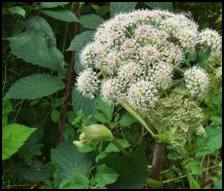You entered European Wild Angelica, the more common name is...

Angelica
SCIENTIFIC NAME:(Angelica archangelica L., Angelica officinalis, Angelica sylvestris)
A biennial aromatic plant and member of the Apiaceae Umbelliferae family, Angelica archangelica grows wild in Finland, Sweden, Norway, Denmark, Greenland, the Faroe Islands and Iceland, mostly in the northern parts of the countries where it is cooler. It can be found growing in wet meadows as well as valleys at the foot of mountain ranges. In its second year, Angelica produces a fluted stem that can each heights of 6 feet. Many serrated leaflets make the leaf of this plant and in July numerous, tiny, yellowish or greenish flowers bloom in globular umbels from which pale yellow oblong fruit grows.
Common Names:
Amara Aromatic, American Angelica, Archangel, Archangelica, Bellyache Root, Dead Nettle, European Wild Angelica, Garden Angelica, Goutweed, High Angelica, Holy Herb, Masterwort, Purple Angelica, Purplestem Angelica, Wild Angelica, Wild Celery
Uses:
Since the 10th century, Angelica has been cultivated as a vegetable and for medicinal purposes. It is also used to flavor liqueurs like Chartreuse and Vermouth. When one chews on a root or drinks tea brewed using this plants aromatic roots, a local anesthesia effect takes place, this will heighten your immune system. Used as a wash this plant has been effective against fungal, bacterial and viral infections. It is some times used in the making of Absinthe.Applications:
Tea:
Cover root with water and bring to a boil. Remove from heat and let steep for 5 minutes. Drink ½ cup twice a day.
Wash:
In a pot, add just enough water to cover root, bring to a boil, lower heat and simmer for 15 minutes. Apply to afflicted area.
Warnings:
It is not advisable to harvest Angelica without a positive identification being made first by a botanist as there are several members of the Apiaceae Umbelliferae family that look the same yet are extremely poisonous.
Diabetics should not use this herb, as it tends to raise one’s sugar. Large doses can affect blood pressure; heart rhythm and respiration so do not exceed dosage guidelines.






